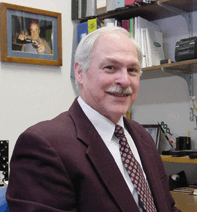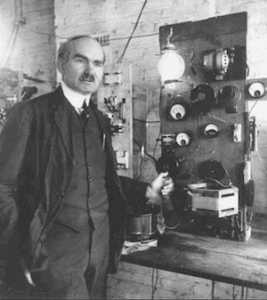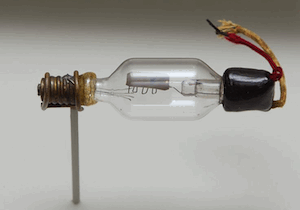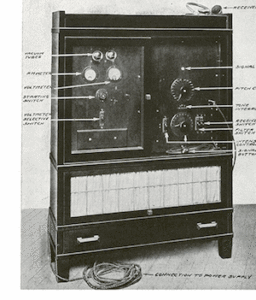At the 2013 Audiology Now meeting in Anaheim, a group of us (Robert Margolis, Charles Berlin, Jay Hall III, and myself, were invited to give a presentation on topics related to the History of Audiology (hearing testing, hearing aids, and vestibular testing). That which follows takes on the format of questions, utilizing materials from the session on “History of Pure-Tone Audiometry” presented by Robert H. Margolis, Ph.D. Presentation materials from the other speakers will be posted in later posts. Wayne Staab, Section Editor
Robert H. Margolis, Ph.D. University of Minnesota and Audiology Incorporated
TEST YOUR KNOWLEDGE
- Who was the German inventor of the electrically driven tuning fork in 1863?
- What is this device, designed in 1879? (Image at right).
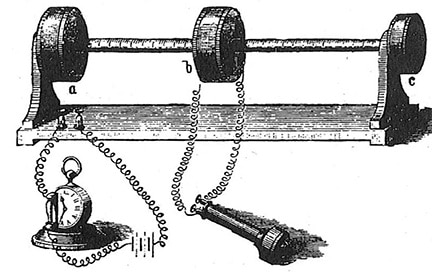
- What Iowa native received an Academy Award in 1959 for introducing sound to movies?
- Who was awarded the Nobel Prize in 1914 while a prisoner in a Russian POW Camp. He finished his career at the University of Uppsala.
- Who was hired in 1917 at the University of Iowa to develop hearing tests and test patients?
- This device was developed in 1919 by Schwarz (Germany), and commercialized by Medico-Technical Company in Berlin. What is this, and why was it unique? (Image at right).

- What was the price, and how many of the Western Electric 1A audiometers were sold (1922)?
- What was the first widely-used audiometer?
- Who published the first detailed paper on audiometric methods?
- The son of a prominent otolaryngologist claimed to have coined the word “audiometer.” Who was that person?
- Who published their “Manual for Rehabilitation of Aural Casualties” in 1944?
- The scientific basis of the Hughson-Westlake method, and recommended use for clinical audiometry, was published by?
- In what year was the first ANSI Standard Method for Manual Pure Tone Audiometry published?
- Who wrote: “The number of audiometric examinations made today has grown to such a magnitude that it is only natural that some of the techniques…should become automated?”
ANSWERS:
- Hermann Ludwig Ferdinand von Helmholtz invented the electrically driven tuning fork in 1863. It helped lead the way to electric measurement of hearing sensitivity. He was a German physician and physicist who made significant contributions to several widely varied areas of modern science. In physiology and psychology, he is known for his mathematics of the eye, theories of vision, ideas on the visual perception of space, color vision research, and on the sensation of tone, perception of sound, and empiricism. In physics, he is known for his theories on the conservation of energy, work in electrodynamics, chemical thermodynamics, and on a mechanical foundation of thermodynamics. As a philosopher, he is known for his philosophy of science, ideas on the relation between the laws of perception and the laws of nature, the science of aesthetics, and ideas on the civilizing power of science. His first important scientific achievement, an 1847 physics treatise on the conservation of energy, was written in the context of his medical studies and philosophical background.
- This is the Hughes Audiometer, developed in 1879 by David Edward Hughes. (a) and (c) are the two primary coils, and (b) is the secondary coil. A Hughes carbon microphone was attached to the clock. Of this device, Benjamin Ward Richardson (England), wrote: “The world of … medicine… is under a deep debt to Professor Hughes for his simple and beautiful instrument which I have christened the audimeter, or less accurately but more euphoniously, the audiometer.” (Proc. Royal Soc. Med., 1879).
- Lee de Forest received an Academy Award in 1959 for
introducing sound to movies. He was an American inventor with over 180 patents to his credit. He named himself the “Father of Radio,” with this famous quote, “I discovered an Invisible Empire of the Air, intangible, yet solid as granite,” In 1906 De Forest invented the Audion, the first triode vacuum tube and the first electrical device that could amplify a weak electrical signal and make it stronger. The Audion and vacuum tubes developed from it established the field of electronics and dominated it for 40 years, making possible radio broadcasting, television, and long-distance telephone service, among many other applications. For this reason De Forest has been called one of the fathers of the “electronic age.” De Forest is also credited with one of the principal inventions that brought sound to motion pictures, most notable his Phonofilm process, a way to make the movies talk by adding a synchronized optical soundtrack to the film. For that 1920 invention, the first sound-on-film process, he received in 1959 an honorary Oscar from the Academy of Motion Picture Arts and Sciences. The inscription read: “Academy Honorary Award to Lee de Forest for his Pioneer Invention which brought Sound to the Motion Picture. Academy of Motion Picture Arts and Sciences, 1959.”
- Robert Bárány (Austria). In 1903, he accepted a post as demonstrator at the Otological Clinic under Professor Politzer. He followed up the theories of Flourens, Purkinje, Mach, Breuer and others, and clarified the physiology and pathology of the human vestibular apparatus. He was awarded the Nobel Prize for his work in this field in 1914. The news of this award reached Bárány in a Russian prisoner-of-war camp; he had been attached to the Austrian army as a civilian surgeon and had tended soldiers with head injuries, which fact had enabled him to continue his neurological studies on the correlation of the vestibular apparatus, the cerebellum and the muscular apparatus. Following the personal intervention of Prince Carl of Sweden on behalf of the Red Cross, he was released from the prisoner-of-war camp in 1916 and was presented with the Nobel Prize by the King of Sweden in Stockholm. Audiology remembers him also as the inventor of the Noise Box for audiometric masking in 1908.
- C.C. Bunch, in 1917. He developed the first sweep frequency audiometer.
- This was the first electronic audiometer with masking, an interrupter key to switch the test tone on and off in order to prevent auditory fatigue, and a Politzer balloon attached to a “pneumatic earphone” for threshold measurements under condition of altered air pressure in the external auditory canal (1919).
- This is the Western Electric 1A audiometer. This was the first electronic audiometer commercialized in the U.S. The price was $1500 and 25 were sold (1922). This was designed and developed by E.P. Fowler and R.L. Wegel.
- The first widely-used audiometer was the Western Electric 2A audiometer
(1923). It ran on dry cells and was designed to meet clinical needs. In the early instruments, normal threshold values for each test frequency had to be established first to provide a reference. The instrument was limited to 8 frequencies at octave intervals between 64 Hz and 8,192 Hz. The intensity range was limited, and an additional booster amplifier was needed to determine the threshold of feeling.
- Dr. Isaac Jones (American otologist) and Dr. Vern Knudsen (American physicist) published the first detailed
 paper on audiometric methods in Laryngoscope, 1924.
paper on audiometric methods in Laryngoscope, 1924. - Maico (Medical Acoustic Instrument Company) was founded by Leland Watson.
His claim to have coined the word “audiometer” is in question based on the 1879 comment by Benjamin Ward Richardson when speaking about the Hughes hearing measurement device (See number 2).
- Walter Hughson, M.D., and Harold Westlake, Ph.D., wrote about this in Supplement to the Transactions of the American Academy of Ophthalmology and Otolaryngology, 1944.
- Raymond Carhart, Ph.D. and James Jerger, Ph.D, published their paper in the Journal of Speech and Hearing Disorders, 1959. This continues to be the preferred method for hearing threshold determination.
- The first ANSI Standard Method for Manual Pure Tone Audiometry was published in 1978.
- This statement is attributed to Wayne Rudmose. He authored Chapter 2, Automatic Audiometry, in Modern Developments in Audiology, 1963, edited by James Jerger, Ph.D.




